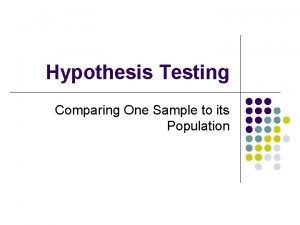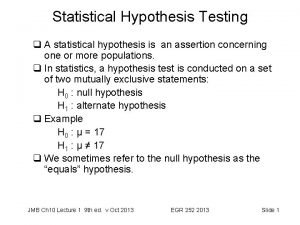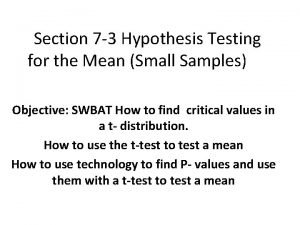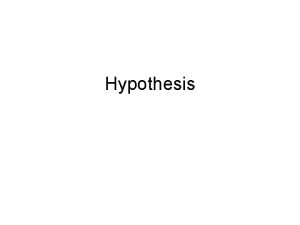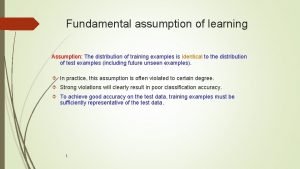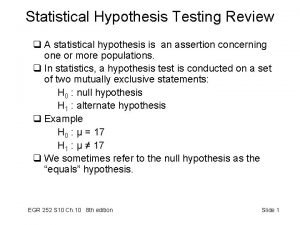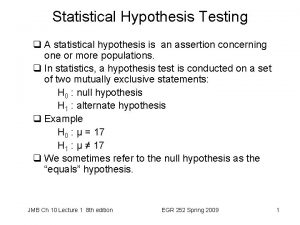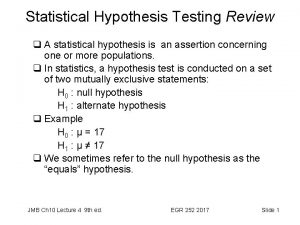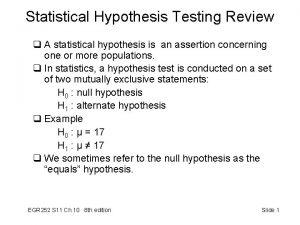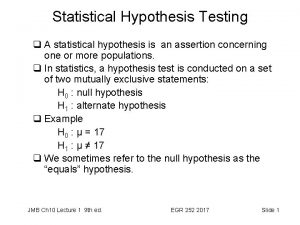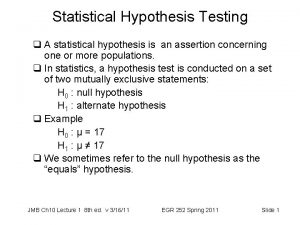Statistical hypothesis A statistical hypothesis is an assumption











- Slides: 11

Statistical hypothesis: A statistical hypothesis is an assumption about a population parameter. This assumption may or may not be true. Poppara…Aquantity or statistical measure that, for a given population, is fixed and that is used as the value of a variable in some general distribution or frequency. E. g. Mean, mode etc

• For instance, the statement that a population mean is equal to 10 is an example of a statistical hypothesis. A researcher might conduct a statistical experiment to test the validity of this hypothesis. • sometimes called confirmatory data analysis, • A statistical hypothesis test is a method of statistical inference

Statistical inference It is when you use statistics to make "inferences" or estimates about a certain aspect of a population. For instance, you could look at a statistic that says Birth rates in Muffin Land are falling. You could 'infer' from that statistic that more women are getting jobs and pursuing a career in Muffin Land this has caused the decline birth rates.

Types of Statistical Hypothesis • Null hypothesis • Alternative hypothesis Null hypothesis • It is an assumption. • The null hypothesis is the proposition that implies no effect or no relationship between phenomena or populations.

• Any observed difference would be due to sampling error (random chance) or experimental error (By human mistake or mechanical error). • The null hypothesis is popular because it can be tested and found to be false. • Also Known As: H 0.

Example of a null hypothesis "Plant growth rate is unaffected by the presence of cadmium in the soil. " A researcher could test the hypothesis by measuring the rate of plant growth of plants grown in a medium lacking cadmium compared with the rate of growth of plants grown in a medium containing different amounts of cadmium. Disproving the null hypothesis would set the groundwork for further research into the effects of different concentrations of the element in soil.

What is Significance levels in statistics The level of statistical significance is often expressed as the so-called p-value. Depending on the statistical test you have chosen, you will calculate a probability (i. e. , the p-value) of observing your sample results.

P value When you perform a hypothesis test in statistics, a p-value helps you determine the significance of your results. Hypothesis tests are used to test the validity of a claim that is made about a population. This claim that’s on trial, in essence, is called the null hypothesis. The alternative hypothesis is the one you would believe if the null hypothesis is concluded to be untrue. The evidence in the trial is your data and the statistics that go along with it. All hypothesis tests ultimately use a p-value to weigh the strength of the evidence (what the data are telling you about the population).

• The p-value is a number between 0 and 1 and interpreted in the following way: • A small p-value (typically ≤ 0. 05) indicates strong evidence against the null hypothesis, so you reject the null hypothesis. • A large p-value (> 0. 05) indicates weak evidence against the null hypothesis, so you fail to reject the null hypothesis.

Alternate hypothesis The alternative hypothesis, denoted by H 1 or Ha, is the hypothesis that sample observations are influenced by some nonrandom cause.

 Formula of test statistic
Formula of test statistic Example of statistical hypothesis
Example of statistical hypothesis Define hypothesis in statistics
Define hypothesis in statistics Null and alternative hypothesis statistics
Null and alternative hypothesis statistics Examples of null hypothesis
Examples of null hypothesis Nebular hypothesis and protoplanet hypothesis venn diagram
Nebular hypothesis and protoplanet hypothesis venn diagram Null hypothesis and research hypothesis
Null hypothesis and research hypothesis Square planar crystal field
Square planar crystal field Realist theory
Realist theory Local markov assumption
Local markov assumption Ieee 1722
Ieee 1722 Assumptions lesson plan
Assumptions lesson plan
